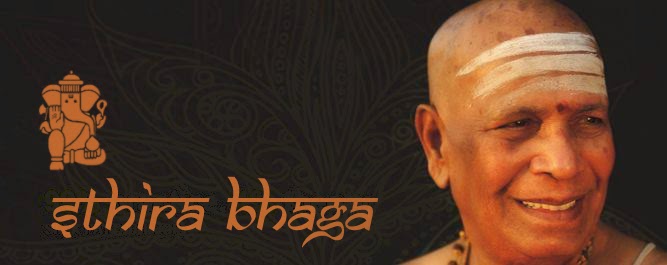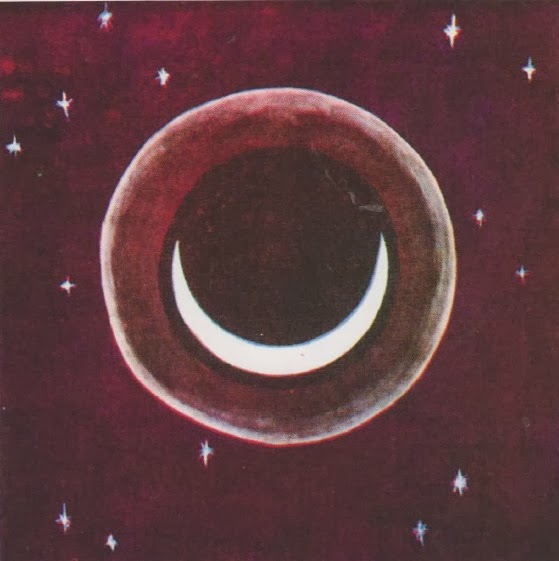Yoga and Therapy
By Sri K Pattabhi Jois
Mind is very fickle, like mercury. Fickle mind, with no discrimination of purity and impurity, flows arbitrarily, conducts itself with no restraints. Because of its unrestrained conduct, the mind influencing the organs of the body not only causes them to become sick, but endangers itself. If the mind becomes one-pointed or fixed, it regulates the organs of the body and protects them from disease. Illusion is also a function of the mind, leading to many sicknesses.
The process of control and purification of mind is called yoga. Maharshi Patanjali has expounded this in an aphorism, Yogah cittavrtti nirodhah, which means that yoga is the process of controlling all the waves of the mind and fixing them on a specified object. This is also called “Astanga Yoga” which has eight fold factors: yama: restraints; niyama: observances; asana: posture; pranayama: breathing practice; pratyahara: sense control; dharana: concentration; dhyana: meditation; Samadhi: contemplation.
These eight factors are divided into two groups called external devices and internal devices. Restraint, observance, posture and breathing practice belong to the external devices. Sense-control, concentration, meditation, and contemplation belong to the internal ones. It is far from easy to practice the internal devices without practicing the external. Therefore, to start with, one should practice the external devices.
Among the external devices, posture and breathing practices stand pre-eminent. Those who are sick and weak, with defective organs, are hardly able to practice restraints and observances. Therefore, we must equip ourselves with sound bodies and organs free from defects, in order to practice restraints and observances. All the Upanishads and all yogis well versed in yoga consider posture and breathing practices as pre-eminent factors among the external devices. An authority for this in the Upanishads reads thus:
Asanam pranasamrodhah pratyharashca dharana | dhyanam samadhiretani shadangani prakirtitah ||
Sri Svatmarama explains this in the Hathayoga Pradipika:
Hathasya prathamangatvat asanam purvamuccate | Tasmat tadasanam kuryat arogyamcangalaghavam ||
This means that one hardly accomplishes any task without good health and buoyancy of limbs. Health and activity of body are essential and hence the importance given to posture and breathing practices.
Asanas are conductive to abating disease and bringing concentration of mind, while the methods of recaka-puraka (exhaling-inhaling) are prerequisites for the practice of posture. Sri Vamana explains in detail the methods of practicing posture. If one practices the postures with no understanding of inhaling and exhaling technique, he is liable to invite untold diseases instead of getting his ailments cured.
Sri Vamana has therefore made it clear:
Vina vinyasa yogena asanadinnakarayet ||
One should not practice posture without the method of inhaling and exhaling
Sri Patanjali also explained breathing practices in his discourse:
Tasmim sati shavasaprashvasayorgati vicchedah pranayamah ||
Pranayamah is a process of inner suspension of the breath (kumbhaka), stopping the inhaling and exhaling.
While inner suspension of breath (kumbhaka) is pranayama, the regulation of recaka and puraka must be adopted in the posture, he adds, which means postures can be practiced only by regulating the exhaling and inhaling.
This method can be learnt only from an experienced yogi well versed in Yoga Shastra. Practicing thus, one is able to drive out physical and mental diseases and fix one’s mind steadfast. As to this yoga, Yagnavalkya says:
Tritiya kālastho rivah svayam samharate prabham | Tritiyange sthitho dehi vikaram manasam tatha ||
Just as the Sun in his third phase, that is, in the evening, drawing forth his sharp rays creates a peaceful atmosphere, in the same way the yogi, practicing the third factor, the postures, frees himself from mental defilements and becomes tranquil.
Hence, the necessity of postures is essential.
A regular practice of postures with regulated breathing can cure many diseases. In order to cure contagious diseases a doctor’s help may be required, but not to cure chronic diseases. Chronic diseases can be healed by postures and breathing practices.
From my own mature experience I can say that many ailments, which cannot be cured by doctors, can be remedied by postures and breathing practices. For example, asthma, diabetes, gastric trouble and rheumatism, known to be incurable by medicines, are cured with no medical aid. These well known ailments, for which no new medicines have been invented, are considered to be irremediable. No medicine so far has overcome these diseases. But it may be repeated that all theses chronic ailments can be healed by yogasanas and pranayamas. Evidence for this is that our institution has brought relief to many chronically affected patients, by proper guidance of postures and breathing practices. Such ailments as paralysis, constipation, piles etc., can be relieved merely by the practice of anupara (liquids) without resorting to any medicine. What is needed essentially to support this yoga knowledge is faith, courage and adventure.
In this scientific age, the criteria for diagnosing diseases have been taken over by machines. We refuse to accept this standard. For example, a patient suffering from blood pressure feels dimness of eyesight, gets increasingly fatigued while doing even a little exertion in work, prefers to keep always lying down. By these symptoms it can be understood that his blood pressure is giving trouble. On the other hand, if none of the above-mentioned symptoms obtain, and if the doctor advices a patient based on the finding of medical equipment alone, the patient by mere hallucination is liable to invite blood pressure difficulty, which he did not originally have. This, therefore, compels me to say that we refuse to admit the theory of diagnosis of diseases by machinery equipment.
By the practice of yoga it is possible to purify many internal pulses, cells, veins, plasma, wind, liver, phlegm, circulation of blood, etc. Thus, the internal purification of the body alone facilitates the cure of ailments. Generally, the purification of any matter requires fire and wind. Just as the gold in a crucible purified by a goldsmith with the aid of fire and wind, which eliminates all the impurities thereof, turns into brilliant gold, similarly the elimination of diseases as impurities needs fire and wind. That is why the wise have said:
Pranayamabhyasayuktasya sarvarogakshyobhavet | Avuktabhyasayuktasya sarvarogasamudbhava ||
One who practices asanas and pranayamas properly finds that all diseases come to naught, whereas all kinds of ailments appear in the practicing improperly.
Asanas are prerequisites for pranayama, which have to be practiced by following the methods of recaka and puraka. Little gain will ensue by asanas practiced with little knowledge of breath control.
Now we have seen how asanas are important for the healing and prevention of diseases. For example, certain asanas are prescribed to cure diabetes: Janushirshasana, baddhakonasana, and upavishtakonasana.
For constipation and ailments of the anus, baddhakonasana is prescribed. In the posture of baddhakona, contracting the anus, one performs the long recakas and purakas. Sri Vamana says that this practice heals the diseases of anus. I know from experience that many have found themselves benefited by these practices.
But to ensure the stability of these asanas, many others must precede them. While practicing the posture prescribed for a certain ailment one must stay in it long enough to perform at least 50 receka-purakas. In this way the ailments become healed. But it cannot be said that by performing only those prescribed asanas, a person can cure a specified ailment. Only when all organs are functioning with proper blood circulation can the ailments recede, not otherwise. To understand this point, one should approach well-versed yogi, which means that a Guru is essential.
In conclusion, one practicing yoga with correct knowledge thereof knows no fear of diseases and sickness. But one gets hardly any benefit out of it, if at the same time he fails to have any regulation over food, habits, speech etc. Therefore, it is my experience, which agrees with the opinion of those well versed in the shastras, that the yoga practitioner practicing with regulation of food, habits, speech and contact will find himself freed from all kinds of ailments, physical and mental.
From: Yoga and Science, Buddha Vacana Trust; Bangalore, India, 1977
Proceedings of the International Conference on Yoga and Psychic Research, in May of 1977, under the auspices of the International Sivananda Yoga Vedanta Centers









.jpg)
